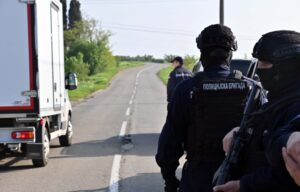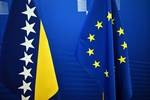
In the European Union, there are over 800 dangerous gangs with more than 25,000 members. Among these criminal networks are those run by people from the Balkans, predominantly from Albania, Bosnia and Herzegovina, and Serbia, with their main activity being drug trafficking.
Data on the number, characteristics, structure, and features of criminal organizations provide insight into the complex, dynamic, and hidden world of the underworld that offers prohibited goods for which there is demand. By analyzing the size, composition, and organization of these groups more deeply, we gain a better understanding of how they function, collaborate, and evolve over time. This knowledge is crucial for police officers, prosecutors, decision-makers, researchers, and the public to develop more successful measures against organized crime.
For example, data on the reduction in the number of criminal organizations in Montenegro, North Macedonia, and Serbia over the past decade is significant. In Montenegro, the number of criminal organizations has halved, while in Serbia, it has decreased almost fivefold. However, these data do not necessarily indicate that criminal groups have been dismantled or weakened. It is possible that they have united, consolidated, and become more effective in their activities, thus becoming more dangerous, as noted in an analysis by the Radar portal.
Police have discovered that nine out of 12 criminal groups in Serbia, as well as 21 out of 46 in North Macedonia, are transnational, meaning they operate both in their own country and abroad. These groups were the subject of analysis by Europol, the European Union's main law enforcement agency, whose report was published in April 2024. According to Europol, there are 821 criminal networks with over 25,000 members across 27 EU member states.
Their primary criminal activities include drug trafficking, fraud, property crimes, money laundering, migrant smuggling, and human trafficking. However, drug trafficking stands out as the key activity, with half (50 percent) of the most dangerous criminal networks involved in this activity, either independently or as part of their operations.
One-third (36 percent) of these networks focus exclusively on drug trafficking. Members of these networks active in Europe also come from the Western Balkans.
A common language often unites criminals from these regions, with national differences not being as significant. Thus, two groups of members from the Western Balkans stand out: one speaking Albanian and the other speaking languages of the former Yugoslav nations. They heavily rely on technology in their work. According to the Belgian Minister of Justice, communication via the Sky ECC application mostly occurred in English, Albanian, and Croatian languages, as reported by the Radar portal.
Criminal networks centered around Albanians consist either exclusively of Albanians or of Albanians in combination with citizens of Belgium, the Netherlands, France, Greece, Italy, and Serbia. However, Albanians are the dominant nationality in over half of these criminal networks. They are active in drug trafficking, arms smuggling, robberies, and migrant smuggling. They operate in numerous EU member states and countries such as Norway, Switzerland, the United Kingdom, and Latin American countries (Brazil, Colombia, and Ecuador).
On the other hand, networks combining membership from different Western Balkan countries are mostly led by Serbs. They include Albanians, Belgians, Bosnians, Croats, Dutch, Germans, Montenegrins, Slovenes, and Turks. Their primary criminal activity is drug trafficking, mainly cocaine and cannabis, and to a lesser extent synthetic drugs and heroin. They also engage in property crimes, cigarette smuggling, and human trafficking for sexual exploitation. They operate mostly in Belgium, Colombia, Croatia, France, Germany, the Netherlands, and Western Balkan countries.
A characteristic of Balkan criminal networks is their significant presence in Latin America. Through corrupt deals with individuals in ports and shipping companies, these networks completely control the cocaine supply chain. They are extremely violent and use violence as retaliation for lost drug shipments or to dominate the illegal market. They are also involved in professional kidnappings, executions, money laundering, arms and explosives smuggling, as well as document forgery. Some members of these networks organize operations from European prisons, as reported by the Radar portal.
Infiltration into legitimate business is a key strategy that criminal networks use to conceal illegal activities and launder money. Eighty-six percent of networks use legal businesses by entering existing ones or establishing new companies. Sectors most vulnerable to organized crime infiltration are construction, hospitality, and transport.
The risk of money laundering in construction is high in all Western Balkan countries. Recently, a group was discovered using drug proceeds in Denmark to launder money through real estate purchases in Serbia.
A third (34 percent) of the most dangerous criminal networks in Europe have been active for more than 10 years, indicating their ability to maintain influence and power, even if leaders and members are arrested or convicted. This also indicates weaknesses in the institutional response to organized crime. If this finding is applied to the Balkans, we can observe that after the downfall of the Zemun Clan in 2003, the same criminal actors often reappear, such as (Darko) Saric's group or organizations associated with the former Kotor Clan and the Amerika group. The same applies to the Albanian network Kompania Bello.
Europol has found that some of the most dangerous criminal networks recruit young people and exploit them to carry out tasks in drug trafficking or exploit them in criminal activities. Balkan criminal groups are not much different in this regard. For example, in Serbia, over the past five years, several young men, the youngest being 17 years old, have been arrested for involvement in executions of members of rival criminal clans. It is often emphasized, especially after the pandemic, that children between the ages of 12 and 15 are used for street drug sales, as reported by the Radar portal.
In conclusion, Europol has depicted the complex landscape of organized crime in Europe and the role of the Balkan underworld. They operate sophisticatedly and transnationally, focusing on illegal goods that yield the highest profits—cocaine. The reduction in the number of criminal organizations in certain Balkan countries over the past decade may indicate changes in their operational strategies rather than weakening of their influence, emphasizing the need for constant vigilance.
Technological dependence, infiltration into legitimate businesses, and youth recruitment highlight multifaceted issues that require enhanced international cooperation, targeted interventions against corruption and money laundering in construction, as well as measures for youth that are often overlooked, as reported by the Radar portal.
Kakvo je tvoje mišljenje o ovome?
Učestvuj u diskusiji ili pročitaj komentare





 Srbija
Srbija
 Hrvatska
Hrvatska
 Slovenija
Slovenija



























































